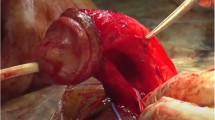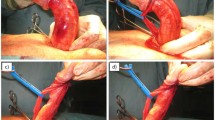Abstract
Surgery is gold-standard for correction of Peyronie’s curvature. Grafting is preferred in advanced deviations. We present our novel surgical technique and early results of grafting with collagen fleece. Patients with stable Peyronie’s disease (PD) were included. Grafting was performed by a ready-to-use collagen fleece coated with tissue sealant (TachoSil, Nycomed, Konstanz, Germany), following partial plaque excision/incision. Results of correction were documented by artificial erection. In all, n=70 consecutive patients underwent surgery. Mean patient age was 56.4 years (range: 33–72); 88.6% of patients had dorsal deviation, 11.4% lateral or ventral deviation. Grafting after partial plaque excision was performed in 61 patients (87.1%), after plaque incision in 2 (2.9%) patients. In the former patients, mean operative time was 94.2 min (range: 65–165). Totally straightness was achieved in 83.6%. Three patients required surgical drainage because of subcutaneous haematoma formation. After mean early follow-up of 5.2 days (range: 2–15), glans sensation was normal in 56 patients (91.8%). Seven patients (10.0%) underwent Nesbit procedure alone. Grafting by collagen fleece in PD is feasible and promising. Major advantages are decreased operative times and easy application. Moreover, an additional haemostatic effect is provided. However, long-term clinical outcomes are necessary to confirm these encouraging findings.
This is a preview of subscription content, access via your institution
Access options
Subscribe to this journal
Receive 8 print issues and online access
$259.00 per year
only $32.38 per issue
Buy this article
- Purchase on Springer Link
- Instant access to full article PDF
Prices may be subject to local taxes which are calculated during checkout




Similar content being viewed by others
References
Kadioglu A, Kücükdurmaz F, Sanli O . Current status of the surgical management of Peyronie’s disease. Nat Rev Urol 2011; 8: 95–106.
Ralph D, Gonzalez-Cadavid N, Mirone V, Perovic S, Sohn M, Usta M et al. The management of Peyronie’s disease: evidence-based 2010 Guidelines. J Sex Med 2010; 7: 2359–2374.
Larsen S, Levine LA . Review of non-surgical treatment options for Peyronie’s disease. Int J Impot Res 2012; 24: 1–10.
Smith J, Walsh TJ, Lue TF . Peyronie’s disease: a critical appraisal of current diagnosis and treatment. Int J Impot Res 2008; 20: 445–459.
Acikgoz A, Gokce E, Asci R, Buyukalpelli R, Yilmaz AF, Sarikaya S . Relationship between penile fracture and Peyronie’s disease: a prospective study. Int J Impot Res 2011; 23: 165–172.
Mulhall J, Schiff J, Guhring P . An analysis of the natural history of Peyronie's disease. J Urol 2006; 175: 2115–2118.
Staerman F, Pierrevelcin J, Ripert T, Menard J . Medium-term follow-up of plaque incision and porcine small intestinal submucosal grafting for Peyronie’s disease. Int J Impot Res 2010; 22: 343–348.
Dukic I, Thakare N, Pearce I, Payne SR . Should assessment of penetrative sexual activity be used as the treatment arbiter in the management of Peyronie’s disease? Int J Impot Res 2011; 23: 70–75.
Gur S, Limin M, Hellstrom WJG . Current status and new developments in Peyronie’s disease: medical, minimally invasive and surgical treatment options. Expert Opin Pharmacother 2011; 12: 931–944.
Simonato A, Varca V, Esposito M, Venzano F, Carmignani G . The use of a surgical patch in the prevention of lymphoceles after extraperitoneal pelvic lymphadenectomy for prostate cancer: a randomized prospective pilot study. J Urol 2009; 182: 2285–2290.
Siemer S, Lahme S, Altziebler S, Machtens S, Strohmaier W, Wechsel HW et al. Efficacy and safety of TachoSil as haemostatic treatment versus standard suturing in kidney tumor resection: a randomized prospective study. Eur Urol 2007; 52: 1156–1163.
Kim D, Lesser TF, Aboseif SR . Subjective patient-reported experiences after surgery for Peyronie’s disease: corporal plication versus plaque incision with vein graft. Urology 2008; 71: 698–702.
Cormio L, Zucchi A, Lorusso F, Selvaggio O, Fioretti F, Porena M et al. Surgical treatment of Peyronie’s disease by plaque incision and grafting with buccal mucosa. Eur Urol 2009; 55: 1469–1476.
Breyer B, Brant WO, Garcia MM, Bella AJ, Lue TF . Complications of porcine small intestinal submucosa graft for Peyronie's disease. J Urol 2007; 177: 589–591.
Kadioglu A, Sanli O, Akman T, Cakan M, Erol B, Mamadov F . Surgical treatment of Peyronie's disease: a single center experience with 145 patients. Eur Urol 2008; 53: 432–440.
Taylor F, Levine LA . Surgical correction of Peyronie’s disease via tunica albuginea plication or partial plaque excision with pericardial graft: long-term follow up. J Sex Med 2008; 5: 2221–2228.
Kalsi J, Christopher N, Ralph DJ, Minhas S . Palque incision and fascia lata grafting in the surgical management of Peyronie’s disease. BJU Int 2006; 98: 110–115.
Knoll L . Use of small intestinal submucosa graft for the surgical management of Peyronie’s disease. J Urol 2007; 178: 2474–2478.
Sansalone S, Garaffa G, Djinovic R, Pecoraro S, Silvani M, Barbagli G et al. Long-term results of the surgical treatment of Peyronie’s disease with Egydio’s technique: a European multicentre study. Asian J Androl 2011; 13: 842–845.
Author information
Authors and Affiliations
Corresponding author
Ethics declarations
Competing interests
The authors declare no conflict of interest.
Rights and permissions
About this article
Cite this article
Hatzichristodoulou, G., Gschwend, J. & Lahme, S. Surgical therapy of Peyronie’s disease by partial plaque excision and grafting with collagen fleece: feasibility study of a new technique. Int J Impot Res 25, 183–187 (2013). https://doi.org/10.1038/ijir.2013.7
Received:
Revised:
Accepted:
Published:
Issue Date:
DOI: https://doi.org/10.1038/ijir.2013.7
Keywords
This article is cited by
-
Intermediate-term results of TachoSil grafting to correct residual curvature during inflatable penile prosthesis implantation in patients with Peyronie’s disease
International Journal of Impotence Research (2023)
-
The use of collagen fleece (TachoSil) as grafting material in the surgical treatment of Peyronie’s disease. A comprehensive narrative review
International Journal of Impotence Research (2022)
-
Efficacy of H-shaped incision with bovine pericardial graft in Peyronie’s disease: a 1-year follow-up using penile Doppler ultrasonography
International Journal of Impotence Research (2021)
-
Is modeling an inflatable penile prosthesis obsolete for patients with Peyronie’s disease?
International Journal of Impotence Research (2020)
-
Strategies and current practices for penile lengthening in severe Peyronie’s disease cases: a systematic review
International Journal of Impotence Research (2020)



